< Previous | Contents | Next >
 ANSFIELD, the second town in importance in the County of Notts, is a Market Town and Parish in the diocese of Southwell; it is a Municipal Borough, a Charter of Incorporation having been granted in 1891.
ANSFIELD, the second town in importance in the County of Notts, is a Market Town and Parish in the diocese of Southwell; it is a Municipal Borough, a Charter of Incorporation having been granted in 1891.
It is situate about fourteen miles, north by west, of Nottingham, on the London and Leeds Road, and is a town of great antiquity, and being in the heart of the ancient Royal Forest of Sherwood was, owing to its convenience for hunting pursuits, the temporary residence of the Mercian Kings. Amidst our illustrations is one of the famous oak known locally as Robin Hood's larder.

Town Hall and Market Cross.
The small river Maun, which rises near Annesley, flows by the town, the name of which, formerly written Maunsfield, was derived from it.
Sherwood Forest was a royal demesne from the time of Edward the Confessor to that of Queen Elizabeth.
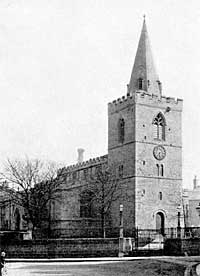
Mansfield Parish Church.
Mansfield is well served by the Midland Railway system, and that it is an important centre is shewn by the fact of the many lines of railway that start from here, including the Mansfield and-Nottingham, Mansfield and Pyebridge, Mansfield and Southwell, Mansfield and Alfreton, and Mansfield and Worksop lines. The latter is carried over the town on a noble viaduct of fifteen arches, a view of which, passing over Church Street, is shown on the next page.
Few towns in the United Kingdom with the same population as Mansfield can boast of as many industries, and first mention should be made of the range of sand hills seen so conspicuously by the traveller entering by the Nottingham line. This sand is famous for its perfect moulding properties, and it is exported to every part of the globe where iron industries exist. Other important industries comprise an extensive coal trade— the output of many large collieries in the neighbourhood, doubling cotton mills, lace curtain manufactures, also many important hosiery works and a number of well-organised iron foundries, whose productions are favourably known and are in increasing demand in many parts of the kingdom. A description of the well-known Meadow Foundry appears amidst our Reviews of Mansfield.
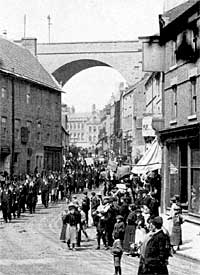
The Viaduct.
Other important industries include the important works in the Rock Valley, devoted to decorative tin-plate printing in colours, of Messrs. Barringer, Wallis and Manners, Ltd., and the no less famous mustard works of Barringer and Co., Ltd. In the same neighbourhood is the important boot factory of Mr. Edmund Weatherall. There are also extensive engine and machine works, corn mills, a tannery and a brewery. The Mansfield Freestone (see illustration) is exported to all parts of the kingdom.
Our views include one of the Town Hall and the beautiful monument on the Market Place erected to the memory of the late Lord George Bentinck. The ancient Parish Church of St. Peter which attracts many visitors is noteworthy for the lower portions of its tower, which are of early Norman architecture. There is a window of the early English order, while the arches, piers and north doors are of the decorated character. The register dates from 1560.
Mansfield possesses a small hospital for accident and emergency cases and a district hospital a few miles out at Mansfield Woodhouse. Our view is of the former commodious building.
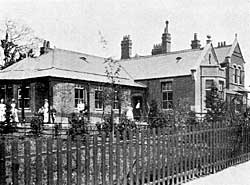
The Accident Hospital.
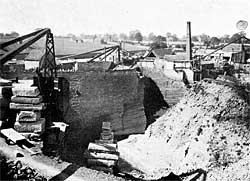
Mansfield Stone Quarries.
At the entrance to the town on the Southwell Road are curious excavations in the Sandstone Rock. The view on page 140 shews the ancient rock habitations, one of which we believe is still inhabited at the present day (1898).
The country around Mansfield and the neighbouring princely habitations in the famous Dukeries country form a never-ending attraction both to the lover of English woodland scenery and of those historical English homes that are famous in every part of the globe where the English race and the English language have penetrated.
Of the latter, perhaps the best known is Welbeck Abbey, the magnificent residence of His Grace the Duke of Portland, situate about four miles south-west of Worksop Station; Clumber Park, the seat of His Grace the Duke of Newcastle, which lies about two miles south-east of Worksop; and Thoresby Park, the seat of Earl Manvers, about eight miles south-east of Worksop.
THORESBY PARK.
The mansion is a noble edifice that was commenced building near the site of the Old Hall, in the year 1864. It is a grand example of modern Elizabethan, and is constructed of Steetley stone. The mansion possesses three fronts, of about 160, 180 and 180 feet respectively. The Park, which is ten miles in circumference, is well timbered and stocked with deer and game.
CLUMBER PARK.
Clumber Park (including the lake of 100 acres) covers some 4,000 acres. For the following details of the mansion we are indebted to "Kelly." The mansion, which occupies a position on the north side of the lake, is large, but of two storeys elevation only; the lower arcaded and the upper storey finished with a balustrading. The south front, facing the lake, is relieved by two projecting blocks, with longitudinally gabled roofs, and the central portion of the facade between these has an open colonnade, with coupled columns of the Ionic order, on high bases. In front an elegantly laid-out terrace garden stretches to the lake.
WELBECK ABBEY.
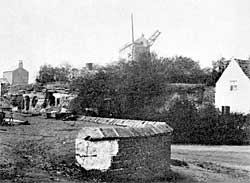
Rock Houses and Inhabitants.
Welbeck Abbey has been written about and described in all its varied and often extraordinary details, perhaps more than any other seat in England. At the present time the main approach is by the Lady Bolsover Drive, but formerly the approach was by a tunnel two miles in length. A former holder of the title spent vast sums of money on the grounds, farm buildings and lodges, and in constructing those subterranean passages or corridors which form a unique feature in the curious attractions of the spot. A magnificent apartment, known as "The Riding School," but actually serving as an Art Gallery, 180 ft. in length, and lighted by four chandeliers aggregating 2,000 jets of gas, is another of the lions of the place; while the Library, the Hall Room and the Bachelors' Hall are amongst the many wonders to be seen by the visitors to famous "Welbeck."

